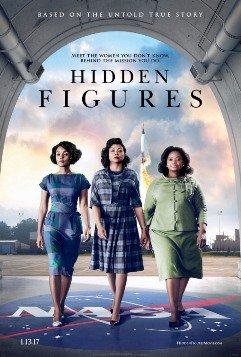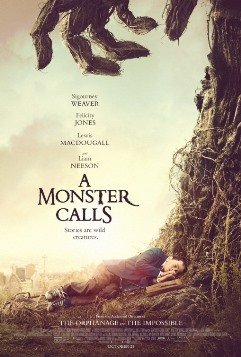January 13, 2017, - 2:25 pm
Last Wknd’s Box Office: Hidden Figures, A Monster Calls


I didn’t post my reviews for last week’s new movies, last Friday, because my internet service went out just as I was about to post them and just before the Jewish Sabbath was going to start. But you didn’t miss much . . .
* Hidden Figures – Rated PG: This movie is about three Black women–Katharine G. Johnson (Taraji P. Henson), Dorothy Vaughan (Octavia Spencer), and Mary Jackson (Janelle Monáe)–who did math calculations to help get American men into space and one of whom taught herself and others how to program and use IBM computers at their infancy of use in the space program. But the movie is largely a race-baiting fraud . . . and a discredit to these three real-life women.
To believe this movie and the excessive, gushing buzz surrounding it, you’d have to buy into the deceitful premise that NASA and its success is due to some uppity Black women who were the only ones who could do math. And you’d have to believe that every single White person at NASA was a despicable, loathsome racist . . . and incredibly stupid (and incapable of doing the math that only the Black chicks could do), to boot. Don’t believe the hype. This movie is absolute BS–both for what it does tell you and what it conveniently excludes. It’s great for the Black Lives Matter crowd and gullible liberal, self-hating White people. But truth, it ain’t.
During the early decades of America’s space program, NASA used “human computers”–women who did math calculations and helped the men determine the angles at which rockets should climb and so on. The computers were primarily White women (check out these photos), but you wouldn’t know it if you watched this movie, as every single computer in this movie is a Black chick. And this movie wants you to believe they were all Black in real life, that the White women didn’t exist. After President Franklin Roosevelt signed an executive order forbidding race-based (and other) discrimination, NACA–the precursor to NASA–began an affirmative action program to recruit Black women to become human computers. The Black women depicted in this movie were specifically recruited to work at NASA’s Langley Research Center in Hampton, Virginia, which is why it appears in the movie that all of NASA’s female human computers were Black. That was not the case.
And, because of Hollywood double standards in the current climate, don’t hold your breath for a “Hidden Figures” movie about White human computers like Barbara Paulson who worked at NASA’s Jet Propulsion Laboratory (JPL):
Barbara Paulson began working at JPL in 1948, when calculating a rocket path took all day. On January 31, 1958, she played a role in the historic launch of the JPL-built Explorer 1, the first successfully launched satellite by the United States. She was tasked with plotting the data received from the satellite and a network tracking station. It was Paulson and her fellow human computers that hand-charted America’s entrance into the Space Race.
Not only is this movie very heavy-handed (every single White person is an out-and-out racist and every Black person is pure as the driven snow), but it’s also filled with made up racist White characters. While the three Black women in the lead roles portray real life Black human computers, the racist lead roles in this movie are all fictional characters, made up for the typical stock racists Hollywood wanted for the narrative. None of the racist NASA Whites played by Jim Parsons, Kevin Costner, and Kirsten Dunst actually existed.
A lot of the racism in the movie was also trumped up and fictional. For instance, there’s a scene in which a Black human computer, Katherine G. Johnson (Taraji P. Henson), is taken for a janitor, there at NASA to empty the garbage. That scene is complete fiction. It never happened and isn’t documented anywhere. Further, Johnson–who figured out the trajectory for John Glenn’s trip into space–didn’t feel like she was the victim of racism or segregation while inside NASA, even though that’s a major story and plot line of the movie. From History vs. Hollywood and an interview the late Mrs. Johnson gave WHRO-TV:
I didn’t feel the segregation at NASA, because everybody there was doing research,” says the real Katherine G. Johnson. “You had a mission and you worked on it, and it was important to you to do your job…and play bridge at lunch. I didn’t feel any segregation. I knew it was there, but I didn’t feel it.” . . . Much of the racism coming from Katherine’s coworkers in the movie seems to be largely made up (in real life she claimed to be treated as a peer).
Yes, racism definitely existed at the time this movie took place. But most of the racism depicted in this movie–including and especially that which is alleged against Katherine Johnson–never happened. These women are to be commended for the great work they did, but to act as if only Black women could do these calculations and that only they did them, is a lie. They got these jobs as a result of affirmative action recruiting. They were clearly smart women and not militants, unlike the way they are portrayed in this movie. The movie shows several scenes in which each of these women eventually blows up and tells off her White co-workers and supervisors. None of that happened in real life. It’s just pure Hollywood. Also fake, that a fictional character–played by Jim Parsons–wouldn’t drink out of the same coffeemaker as Johnson. It never happened.
These three women and other computers did great work for the space program. They should be proud. But this movie–pretending they were the victims of non-stop racism by “idiotic men” at NASA–is an embarrassment.
Nothing–no Hollywood propaganda, nor any other such production of lies–can change this historical fact: White men built NASA. Both White–AND Black–women helped out. But they were accessories, not the people who ran the show.
***
One other thing: I note that while this movie rightfully celebrates Black women who were brilliant at math, today Blacks are notably behind in math and the rest of the STEM disciplines. Maybe instead of gloating over the past (a past carefully tailored and massaged as truth in this movie) and harping over racism, Black Americans should get back to teaching their community basic math and science, instead of worshiping and pimping the hip-hop culture of idiocy and depravity. Maybe they should make a movie about how Black American culture that once stressed education, now stresses rap videos and bitches and hos.
THREE OBAMAS PLUS FOUR MICHELLE LAVAUGHN ROBINSON HUSSEIN OBAMA IDI AMIN DADAS
![]()
![]()
![]()
![]()




Watch the trailer . . .
* A Monster Calls – Rated PG-13: This was supposed to debut at Christmastime (as it did in some major cities) and it takes place around Christmas. So I was going to call it “The Feel-Good My-Mom-is-Dying-of-Cancer Movie of the Year!” It’s just awful. Dark and dreadful. And, yet, it’s aimed at kids. If I had them, I wouldn’t let my kids see this. It’s scary, sad, and incredibly depressing. Not to mention, pointless. Plus, the movie moved slowly and seemed to go on forever. Mostly a bore.
The story: a 12-year-old boy in suburban London is mercilessly beaten up, bullied and ostracized at school. His mother (the vastly overrated, flat-noted Felicity Jones) is a single mother, whose husband abandoned them for a new family in America. The mother (Jones) is very sick with cancer and is dying, though the boy keeps hoping for a turnaround. Because things have gotten so bad, the boy has had to move in with his grandmother (Sigourney–real name: Susan–Weaver), whom he hates. Also, his mother is so sick that his father has returned briefly from America to see him, despite not having seen his son in a long while. He asks his father if he can go live with them in California, but his father says there is no room, as he’s too occupied with his current wife and child (a daughter).
While all of this is going on, the boy draws pictures and plays with his toys in a way that depict a giant monster with tree-like limbs. Soon, the monster begins appearing in the boy’s life, mostly at night. The monster tells the boy three fables that have lessons and morals associated with them. The monster is stern, angry, loud, and forceful, but his fables have value that the boy eventually discovers.
The fables were the only interesting part of this otherwise horrible, miserable movie. They included lessons for the boy that are of value, such as: things are not always as you see them or as they appear, so don’t accept them at face value because you don’t always know the whole story. Another moral: that he who will dump his principles for something important will dump them for anything and is not worth troubling yourself for.
The fables included a religious minister who did not believe in medicinal cures and ostracized the medicine man. But one day, his daughters were dying of an incurable illness for which only the medicine man had the cure. He begged the medicine man to help heal his daughters and said he was willing to abandon all of his religious faith in return. But the medicine man said no because he said, “You are willing to drop your religious views in order to save your daughters? Then you are a fake, a phony, and I will not help you.” Another fable was about a supposedly evil queen who had the wife of her stepson, the prince/king-to-be, murdered. Or did she? Again, things are not always as they seem. The animated stories, as I noted, were entertaining.
Sadly, the rest of the movie was not. A colossal waste of time.
ONE MARX

Watch the trailer . . .
Tags: A Monster Calls, A Monster Calls movie, A Monster Calls movie review, A Monster Calls review, Dorothy Vaughan, Felicity Jones, Hidden Figures, Hidden Figures movie, Hidden Figures movie review, Hidden Figures review, human computers, Janelle Monáe, Jim Parsons, Katharine G. Johnson, Kevin Costner, Kirsten Dunst, Mary Jackson, movie, movie review, Movie Reviews, Octavia Spencer, Sigourney Weaver, Taraji P. Henson


Hi Dear Debbie Thanks for the info and Thanks for sharing many important things that i do not know at all. God bless Debbie God Bless America God bless Israel. very sincerlly yours Tirdad.
TIRDAD GHARIB on January 14, 2017 at 11:05 am